中考英语语法系列复习专题名词
- 格式:doc
- 大小:56.50 KB
- 文档页数:5
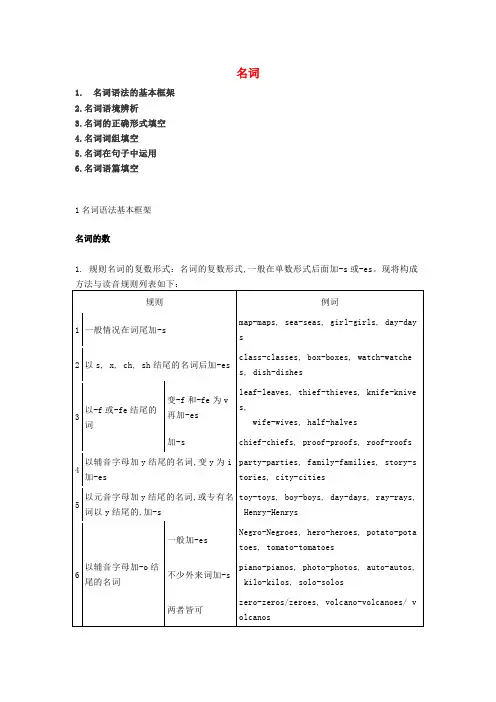
名词1. 名词语法的基本框架2.名词语境辨析3.名词的正确形式填空4.名词词组填空5.名词在句子中运用6.名词语篇填空1名词语法基本框架名词的数名词的所有格名词单复数的判断1.如何判定是可数名词还是不可数名词①可数名词有单数和复数两种形式,如:desk,desks;②可数名词前面可以被基数词,不定冠词(a/an),many修饰,如:three boys,an apple, many students。
2.如何判定是不可数名词①不可数名词没有复数形式,如:tea,meat;②不可数名词,若表示数量,可用量词加不可数名词,如:a piece of paper, two cups of tea。
3. 常见的名词修饰词①只修饰可数名词的修饰语few 几乎没有a few 有几个several 有几个many 很多a couple of 两个a number of 若干a great/large number of 许多②只修饰不可数名词的修饰语little很少,几乎没有a little有一点儿much很多a good/great deal of很多a bit of有一点儿a large amount of大量的③既可修饰可数名词又可修饰不可数名词的修饰语some 一些a lot of 很多lots of 很多plenty of 充足的enough 足够的most 大多数的hardly any 几乎没有the rest of 剩下的名词拓展1.voice, noise, soundvoice指人的说话声或唱歌声,指人的“嗓音”;noise是“吵闹声、噪音”,指不悦耳的声音;sound指自然界中的任何声音。
2.work与jobwork是不可数名词,指需花费体力和脑力的工作;job是可数名词,多指“零工”或“短工”。
例:a part-time job一份兼职工作;out of work 失业3.family, home, housefamily强调整体,指“家、家庭”时,谓语动词用单数;强调个人,指“家庭成员”时,谓语动词用复数;不用于指住房。
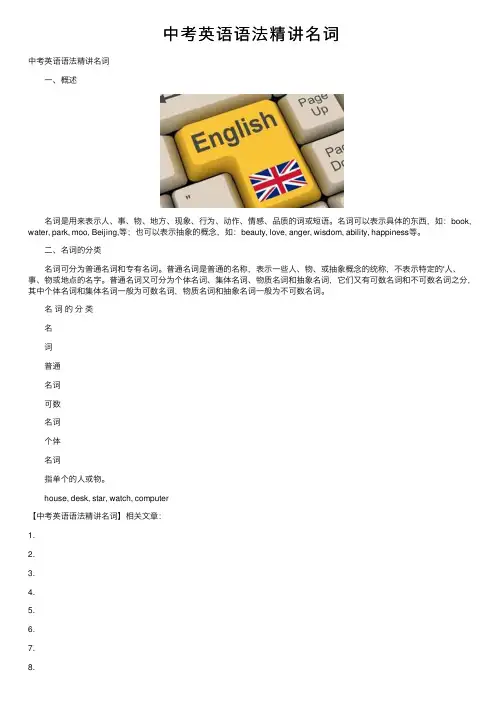
中考英语语法精讲名词
中考英语语法精讲名词
⼀、概述
名词是⽤来表⽰⼈、事、物、地⽅、现象、⾏为、动作、情感、品质的词或短语。
名词可以表⽰具体的东西,如:book, water, park, moo, Beijing,等;也可以表⽰抽象的概念,如:beauty, love, anger, wisdom, ability, happiness等。
⼆、名词的分类
名词可分为普通名词和专有名词。
普通名词是普通的名称,表⽰⼀些⼈、物、或抽象概念的统称,不表⽰特定的'⼈、事、物或地点的名字。
普通名词⼜可分为个体名词、集体名词、物质名词和抽象名词,它们⼜有可数名词和不可数名词之分,其中个体名词和集体名词⼀般为可数名词,物质名词和抽象名词⼀般为不可数名词。
名词的分类
名
词
普通
名词
可数
名词
个体
名词
指单个的⼈或物。
house, desk, star, watch, computer
【中考英语语法精讲名词】相关⽂章:
1.
2.
3.
4.
5.
6.
7.
8.
9.。
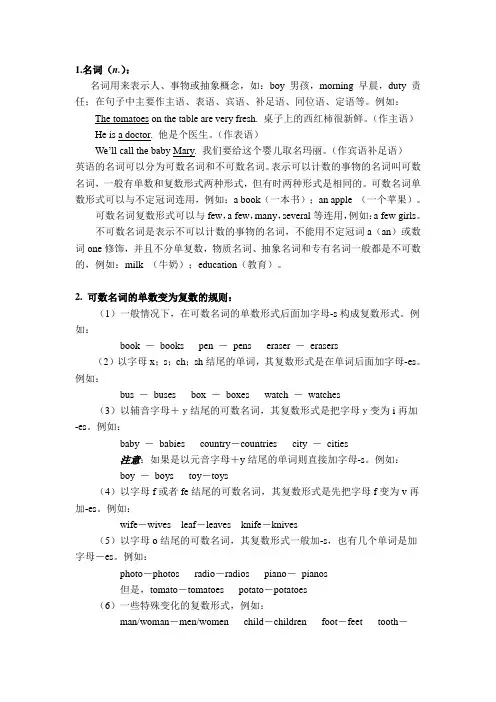
1.名词(n.):名词用来表示人、事物或抽象概念,如:boy 男孩,morning 早晨,duty 责任;在句子中主要作主语、表语、宾语、补足语、同位语、定语等。
例如:The tomatoes on the table are very fresh. 桌子上的西红柿很新鲜。
(作主语)He is a doctor. 他是个医生。
(作表语)We’ll call the baby Mary. 我们要给这个婴儿取名玛丽。
(作宾语补足语)英语的名词可以分为可数名词和不可数名词。
表示可以计数的事物的名词叫可数名词,一般有单数和复数形式两种形式,但有时两种形式是相同的。
可数名词单数形式可以与不定冠词连用,例如:a book(一本书);an apple (一个苹果)。
可数名词复数形式可以与few,a few,many,several等连用,例如:a few girls。
不可数名词是表示不可以计数的事物的名词,不能用不定冠词a(an)或数词one修饰,并且不分单复数,物质名词、抽象名词和专有名词一般都是不可数的,例如:milk (牛奶);education(教育)。
2. 可数名词的单数变为复数的规则:(1)一般情况下,在可数名词的单数形式后面加字母-s构成复数形式。
例如:book -books pen -pens eraser -erasers(2)以字母x;s;ch;sh结尾的单词,其复数形式是在单词后面加字母-es。
例如:bus -buses box -boxes watch -watches(3)以辅音字母+y结尾的可数名词,其复数形式是把字母y变为i再加-es。
例如:baby -babies country-countries city -cities注意:如果是以元音字母+y结尾的单词则直接加字母-s。
例如:boy -boys toy-toys(4)以字母f或者fe结尾的可数名词,其复数形式是先把字母f变为v再加-es。
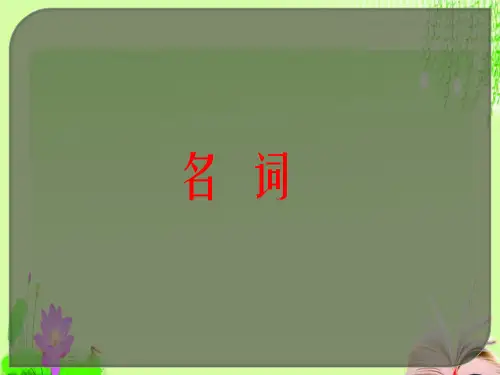
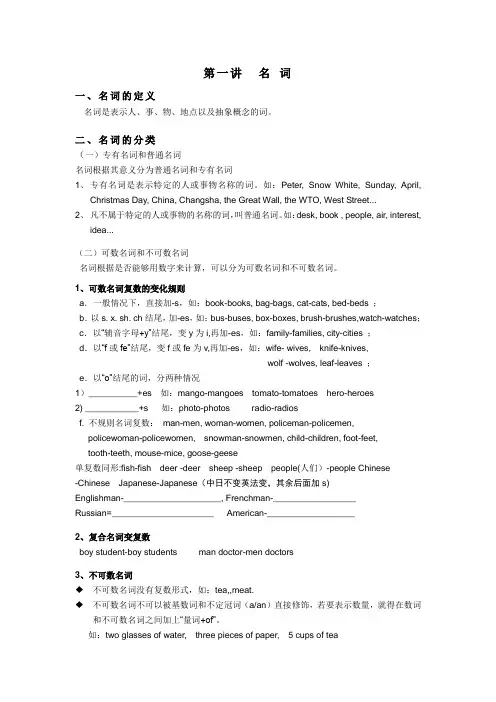
第一讲名词一、名词的定义名词是表示人、事、物、地点以及抽象概念的词。
二、名词的分类(一)专有名词和普通名词名词根据其意义分为普通名词和专有名词1、专有名词是表示特定的人或事物名称的词。
如:Peter, Snow White, Sunday, April,Christmas Day, China, Changsha, the Great Wall, the WTO, West Street...2、凡不属于特定的人或事物的名称的词,叫普通名词。
如:desk, book , people, air, interest,idea...(二)可数名词和不可数名词名词根据是否能够用数字来计算,可以分为可数名词和不可数名词。
1、可数名词复数的变化规则a.一般情况下,直接加-s,如:book-books, bag-bags, cat-cats, bed-beds ;b.以s. x. sh. ch结尾,加-es,如:bus-buses, box-boxes, brush-brushes,watch-watches;c.以“辅音字母+y”结尾,变y为i,再加-es,如:family-families, city-cities ;d.以“f或fe”结尾,变f或fe为v,再加-es,如:wife- wives, knife-knives,wolf -wolves, leaf-leaves ;e.以“o”结尾的词,分两种情况1)__________+es 如:mango-mangoes tomato-tomatoes hero-heroes2) ___________+s 如:photo-photos radio-radiosf. 不规则名词复数:man-men, woman-women, policeman-policemen,policewoman-policewomen, snowman-snowmen, child-children, foot-feet,tooth-teeth, mouse-mice, goose-geese单复数同形:fish-fish deer -deer sheep -sheep people(人们)-people Chinese-Chinese Japanese-Japanese(中日不变英法变,其余后面加s)Englishman-____________________, Frenchman-_________________Russian=_____________________ American-__________________2、复合名词变复数boy student-boy students man doctor-men doctors3、不可数名词◆不可数名词没有复数形式,如:tea,,meat.◆不可数名词不可以被基数词和不定冠词(a/an)直接修饰,若要表示数量,就得在数词和不可数名词之间加上“量词+of”。
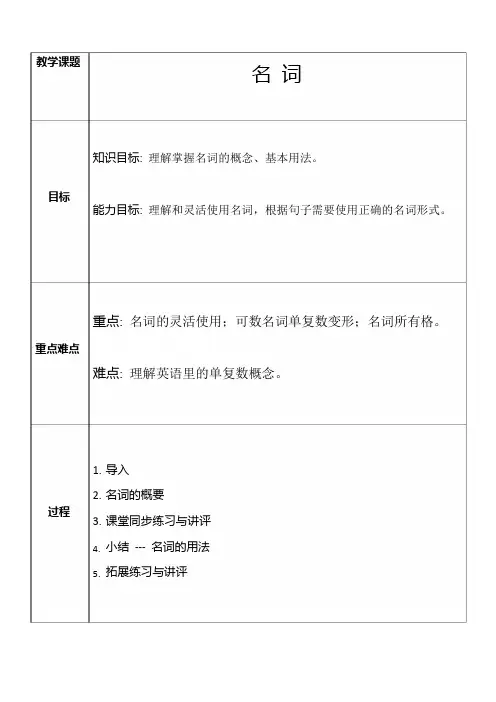
教学课题名词知识目标:理解掌握名词的概念、基本用法。
目标能力目标:理解和灵活使用名词,根据句子需要使用正确的名词形式。
重点:名词的灵活使用;可数名词单复数变形;名词所有格。
重点难点难点:理解英语里的单复数概念。
过程1.导入2.名词的概要3.课堂同步练习与讲评4.小结---名词的用法5.拓展练习与讲评专有名词名词名词意义:表示人、事物或抽象概念的词。
如:Shanghai,Lilei,desk普通名词国名地名人名可数名词不可数名词团体机构名称首字母大写个体名词表单个的人或者事物集体名词表一群人或一些事物的总称抽象名词表无法分为个体的物质物质名词表抽象概念的词如:Jim,June,China,Harbin.teacher,apple…family,police…water,money…health,friendship…1.可数名词(个体名词和集体名词):有单复数之分A.不规则变化常见的有:单复数同型:man-men,woman-women,foot-feet,tooth-teeth,child-children,mouse-mice... Chinese Japanese people sheep deer fish(中日友好永不变)a Chinese---two Chinese;a Japanese--- four Japanese(英法联盟a变e)an English--- eight Englishmen;an Frenchman---nine Frenchmen (其他后面加s)a German---five GermansB.规则变化情况一般的词以s,sh,ch,x结尾以0结尾以辅音+y结尾以f/fe结尾构成+s+es有生命,+es;无生命,+s改y为i+es改f为v+es例词day-days desk-desksmatch-matches boss-bossestomatoes,potatoes,heroesbaby-babies fly-flieswife-wives leaf-leavesphotos,kilos, 1. Some ____ and ____ will come to visit our school next month.A. Germans; EnglishmansB. Germen; EnglishmenC. Germans; EnglishmenD. German; Englishman2.Look! There are three ______ and two ______ at the school gate. Let ’s show them around our school.A. Frenchman; GermanB. Frenchmen; GermanC. Frenchmen; GermansD. Frenchmans; Germans写出下列名词的复数形式1piece shoe orange lake23456789busbodyboylifezootomatomanGerman foxcitykeyleafpianoherowomanChinese glassenemyholidayyourselfradiotoothfishermanchild wishbabywaywolfphotofootapplesheepC.复合名词的复数变化规则: man 和 woman 都要变 girl 和 boy 却不变1 men doctors boy students 1. They are________.2women drivers girl football playersA.man doctorB.men doctorsC.men doctorD.man doctorsD.常考可数名词knifesecond chance size decisionvoicestomachacheminute mistake shape invitationtastetoothachequarter question invention concertsmellcoldhour problem discovery playexpressionfeverweek idea message ticketintroductioncoughyear suggestion difference sightcelebration1.If you work harder, you'll have another_________ to play the violin at a concert.A. sleepB. chanceC. mistakeD. problem2.-Lily, could you please pass me the_________? I want to cut the apple.-Sure, here you are. A. pen B. pencilC. bookD. knifeE.常见复数标志all/both基数词two...many/someseveral几个a few/fewotherthese/thosedifferentare/were在一般现在时的条件下,遇到复数名词,或代词,动词用原形:we all come from China.1.Those white socks____small.A.areB.isC.amD.do2.How many_____do they have?A.pictureB.picturesC.a picture3.We are_____,but they are________.A.Germans;JapaneseB.Germen;JapaneseC.Germans;JapanesesD.Germen;Japanese4.__________turn green in spring.A.LeafB.LeavesC.LeaveD.Leafs5.Look!The kites in the sky are in different_____.Some are big and some are small.A.sizeB.sizesC.colorD.colors6.I can see some________on the hill.A.sheeps and deersB.sheep and deerC.sheeps and deerD.sheep and deers2.不可数名词(1)不可数名词没有复数形式,不能与a/an或具体数字连用,但特指某物时可以与定冠词the连用。
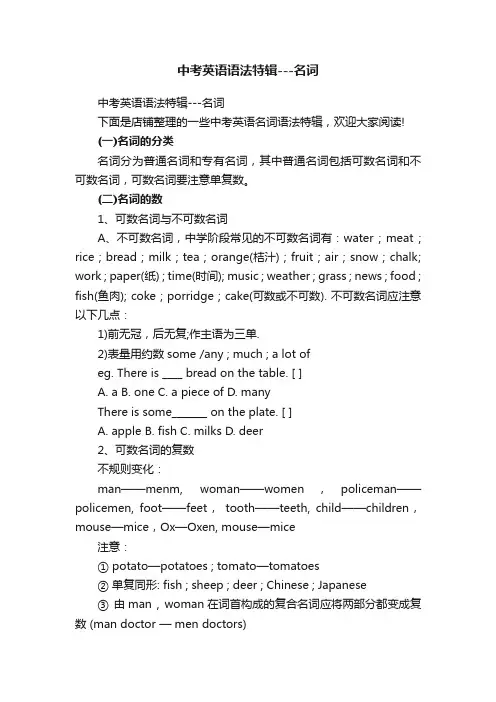
中考英语语法特辑---名词中考英语语法特辑---名词下面是店铺整理的一些中考英语名词语法特辑,欢迎大家阅读!(一)名词的分类名词分为普通名词和专有名词,其中普通名词包括可数名词和不可数名词,可数名词要注意单复数。
(二)名词的数1、可数名词与不可数名词A、不可数名词,中学阶段常见的不可数名词有:water ; meat ; rice ; bread ; milk ; tea ; orange(桔汁) ; fruit ; air ; snow ; chalk; work ; paper(纸) ; time(时间); music ; weather ; grass ; news ; food ; fish(鱼肉); coke ; porridge ; cake(可数或不可数). 不可数名词应注意以下几点:1)前无冠,后无复;作主语为三单.2)表量用约数some /any ; much ; a lot ofeg. There is ____ bread on the table. [ ]A. aB. oneC. a piece ofD. manyThere is some_______ on the plate. [ ]A. appleB. fishC. milksD. deer2、可数名词的复数不规则变化:man——menm, woman——women,policeman——policemen, foot——feet,tooth——teeth, child——children,mouse—mice,Ox—Oxen, mouse—mice注意:① potato—potatoes ; tomato—tomatoes② 单复同形: fish ; sheep ; deer ; Chinese ; Japanese③ 由man , woman在词首构成的复合名词应将两部分都变成复数 (man doctor — men doctors)④ reef—reefs⑤ “某国人”的复数:口诀是“eg. German—Germans⑥有些名词既可作可数名词也可作不可数名词,但词义有所不同。
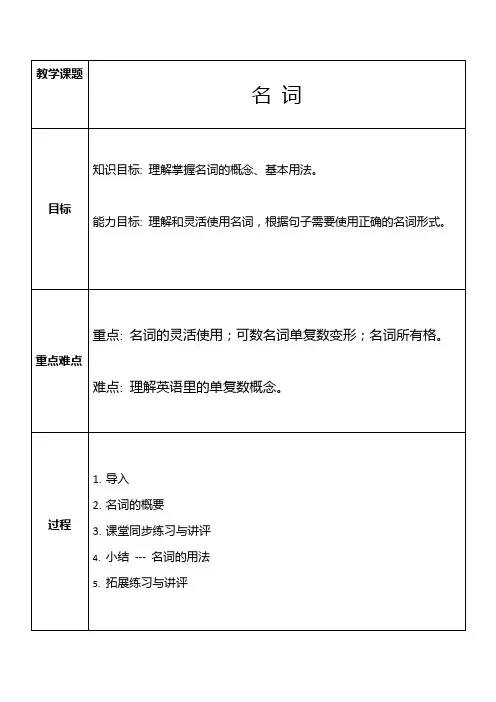
5. Your mother cooks nice __________. I like it very much.A. breadB. beefsC. eggsD. dumplings6.-How can I get some ______ about the 2016 Olympic Games? -Why not search the Internet?A. informationB. experienceC. practiceD. success7.______ about the sports meeting make us excited.A. NewsB. InformationC. MessagesD. Advice8.The Belt and Road initiative(一带一路倡议) will help China improve ______ with lots of countries.A. relationshipB. agreementC. environmentD. progress3.名词的所有格: 在英语中,有生命的名词及表示时间、距离、国家、城市的名词,常在词尾加's 表示所属关系,叫做名词的所有格。
翻译成:"的"。
如:Tom's bike (汤姆的单车)。
名词的所有格例词、例句①直接在词尾加's Kate's bag, Children's Day, Women's Day②以s结尾的名词所有格,在词尾加' Teachers' Day, students' books③表示两人共同拥有的人或物,在后一个人名后加's Lucy and Lily's mother (共同的妈妈)④表示两人分别拥有的人或物,则两个人名后都要加's Tom's and Jim's rooms (各自的房间)⑤表某人的家、店铺、住宅、公共建筑等地名时,所有格后面的名词常常省略at the doctor's(在医务室); at Tom's (在汤姆的家)⑥表示无生命名词的所有格,用of 表达the door of the room, the color of the clothes⑦双重所有格:用's所有格/名词性物主代词与of 所有格相结合。

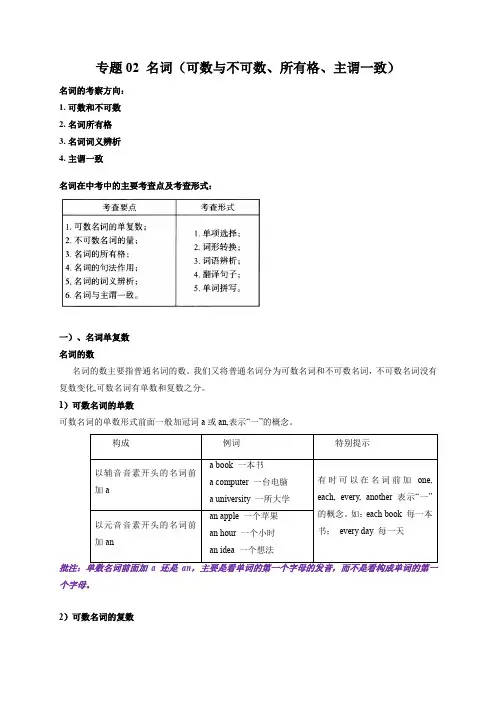
专题02 名词(可数与不可数、所有格、主谓一致)名词的考察方向:1.可数和不可数2.名词所有格3.名词词义辨析4.主谓一致名词在中考中的主要考查点及考查形式:一)、名词单复数名词的数名词的数主要指普通名词的数。
我们又将普通名词分为可数名词和不可数名词,不可数名词没有复数变化,可数名词有单数和复数之分。
1)可数名词的单数可数名词的单数形式前面一般加冠词a或an,表示“一”的概念。
个字母。
2)可数名词的复数A.Chinese,Japanese,police,people,deer,sheep,fish,口诀:中日警察好友来聚会,鹿、羊、鱼、牛齐齐把家回。
B. 在英语名词复数中,表示(某)国人的名词复数有些加S,有些又不加,学生常常会出错。
这里有一条顺口溜就能帮助学生解决这一问题。
它是:“中日瑞不变,英法都要变,其他国人加S”。
常见国家人的复数形式:C. 极少数单词,其复数形式没有任何规律,可借助口诀帮助记忆goose-geese;mouse-mice;man-men;woman-women;tooth-teeth; foot-feet,child-children另一些名词则以复数词出现的机会较多例clothes衣服;shoes鞋子;sunglasses太阳镜;shorts短裤;scissors剪刀;glasses眼镜;shears大剪刀trousers长裤3)可数名词的数量表达A.可数名词可以借助量词来表达,of后面用名词复数,尤其是成双成对的名词复数。
如:a pair of glasses three pairs of trousers a pair of scissors a pair of trousers a pair of glassesa pair of socks a pair of gloves a pair of shoes可数名词借助量词来表达时要注意:后面虽然用复数,动词要根据前面的量词来决定。
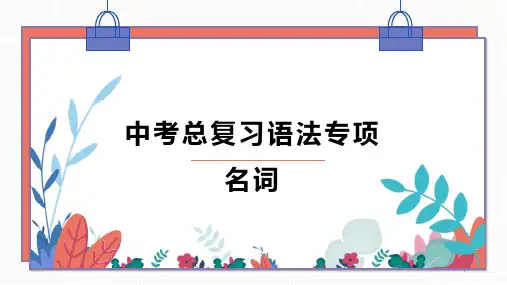
名词1、 名词的分类专有名词单数名词表泛指,在前面加a /an.可数名词:有单数和复数之分普通名词 复数形式通常加 -s/-es 不可数名词:没有复数形式 物质名词、抽象名词、专有名词 用some/any/a little/a lot of 修饰2) 不规则变化①有些名词以-s结尾,但表达单数意义。
科学名词:physics, mathematics/maths 游戏名称:bowls专有名词:the United States, Niagara Falls 其他名词:news, falls②名词做定语,不用复数形式.e.g. a shoe shop, an apple tree*例外:man, woman作定语时,如果后面的名词是复数,则man, woman也要变。
e.g. a woman teacher → three women teachersa man doctor → many men doctors③people, police做“人们”讲时,看作复数,不能在后面加”-s”,谓语动词用复数形式。
family, class是集体名词,既指单数,又指复数,谓语动词可用单数亦可用复数,具体根据语境而定。
④其前不用冠词a/an或数词,但可用much, a little, a lot of/lots of, some,—Look at the clouds, so beautiful!—Wow, so many different _______, horses, sheep, flowers…A. sizesB. shapesC. colorsD. stylesThere are some _______ in Dayton Art Museum. For example, n o food or drink is allowed inside.A. jobsB. recordsC. rul esD. paintings—Yesterday, my father bought me a new mobile phones as a pr esent, but I don’t know how to use it.—Why not read the _______ first before using it?A. expressionsB. applicationsC. adve rtisementsD. instructionsThese _________ have saved many children’s lives.A. woman doctorsB. women doctorC. women doctorsD. woman doctor---What would you like to drink, _______or orange? ---Orange, please.A. hamburgerB. chipC. tea3、不可数名词的数1) 可以修饰不可数名词的词或短语:a lot of , lots of, some, a little, little2) 数词+ 量词 + of + 不可数名词e.g. a glass of water → two glasses of watera cup of tea → three cups of tea3) 常用的不可数名词food, meat, fish, chicken, pork, beef, mutton, orange, milk, tea, coke, water, rice, bread, homework, news, paper, ice, rain, snow, wind, cloud, air, weather, maths, Chinese, English, music, information, fun, work 等.4) 有些不可数名词以复数形式出现时,意思有变化.5) 有些名词,既可以作可数名词,又能做不可数名词,但含义不同Exercises:—Mum, I’ve heard that we can’t eat ____ those days. Is it true?—Take it easy. It is safe to eat cooked meat.A. chickenB. chickensC. a chickenD. the chickenThe students of Grade 7 visited Mike’s farm and saw many ___ there.A. birdB. duckC. sheepD. rabbitI’m so hungry. Please give me ___ to eat.A. three breadB. three pieces of breadC. three pieces ofbreads D. three piece of breadI want a sweet milk. Put some ______ in my cup, please.A. iceB. soupC. saltD. sugar—What a good ______ you’ve given me! Thanks a lot.—My pleasure.A. informationB. newsC. suggestion D. advice4、名词的所有格分类构成方法例子表示有生命的名词所有格在单数后面加-’s The teacher’s officeLily’s photo 以加-s的复数名词后加“’”The teachers’ officeBoys’ games 不以-s 结尾的复数名词后加“-’s”The children’s palace.用and 连接两个并列的单数名词表示共有时,在后一个词尾加-’s;如果不是,则需要分别加在两个名词后面。
中考英语一轮复习语法专项解析突破—名词【知识突破】1、英语名词可分专有名词和普通名词两大类专有名词是个别的人、地、物、团体、机构等的专用名称。
专有名词中实词的第一个字母要大写。
如:Beijing, Tom, the People’s Republic of China 专有名词如果是含有普通名词的短语,则必须使用定冠词the。
如:the Great Wall(长城)姓氏名如果采用复数形式,则表示该姓氏一家人(复数含义),如:the Greens( 格林一家人)。
普通名词是许多人或事物的共有名称。
如:pupil, family, man, foot.普通名词又分为可数名词和不可数名词。
▲可数名词是可以用简单的数词进行计数的名词,如:box, child, orange;▲不可数名词是不可以用简单的数词进行计数的名词。
如:water, news, oil, population, information .2、英语可数名词的单复数:英语可数名词有单数和复数两种形式。
(1)名词由单数变复数的基本方法如下:①在单数名词词尾加s。
如:map → maps,boy→ boys,horse→ horses, table→ tables.②s,o,x ,sh,ch结尾的词加es.如:class→classes, box→boxes, hero→heroes, dish→dishes, bench→benches.[注]:少数以o结尾的词,变复数时只加s。
如:photo→photos, piano→pianos.③以辅音字母加y结尾的名词,变y为i,再加es。
如:family→families, city→cities, party→parties.④以f或fe结尾的名词,变f或fe为v,再加es。
如:shelf→shelves, wolf→wolves,life→lives, knife→knives.(2)不规则变化:man→men, woman→women, sheep→sheep,tooth→teeth, fish→fish, child→children, ox→oxen, goose→geese不可数名词一般没有复数形式,说明其数量时,要用有关计量名词。
中考语法考点总结专题一名词一、普通名词和专有名词:1、普通名词:一般性的人、事、物、抽象概念(如apple, tree, book)2、专有名词:特定的人、事、地、物的名称(如New York, Titanic)二、可数名词和不可数名词:区分技巧:无限分割后,部分仍能代表整体则是不可数名词,反之则是可数名牛肉”无限分割之后还是牛肉,所以beef是不可数名词;“汽车”无限分割后的一个部件不能代表一辆车了,所以car是可数名词。
1、可数名词:不加量词也能量化的事物。
①单数:注意a/an的使用a university, a uniform, a useful bookan hour, an honest boy, an unusual journey②复数:连字符和复数不能同时存在2、不可数名词:必须加量词才能量化、或无法量化的事物。
如:a piece of news, a slice of beef, a plume of smoke...①不可数名词作主语,谓语动词用单数如:Beef is very expensive here.三、名词所有格,表示“……的”1、构成方法:①在名词后加-’s,如:the teacher’s office 老师的办公室②以s结尾的名词后加’,如:the teachers’ office 老师们的办公室2、使用情况:①两者共有:Jack and Tom’s house is big.(Jack和Tom共有的房子)②两者分别有:Jack’s and Tom’s house are big.(Jack和Tom分别有的房子)3、of表示的所有格①A of B 表示“B的A”(翻译的时候从后往前倒着翻,of翻译成“的”)如:the doors of our classroom 我们教室的门4、双重所有格如:He is a friend of your father’s. 他是你父亲的一个朋友。
语法系列复习专题一-----名词名词的分类专有名词:指某人,某地,某机构等专有的名称,其首字母要大写。
如HongKong,China,Bill Clinton,Red Cross个体名词:表示某类人或东西中的个体,如 student,book名普可数名词词通集体名词:表示若干个体组成的集合体,如:family,school,group, people 名词不可数名词物质名词:表示无法分为个体的实物,如:cotton,air,tea抽象名词:表示抽象概念,如:work,happiness,news 2.名词的复数可数名词有单、复数形式,其复数的构成规则如下:1)绝大多数在词尾加s。
如:book,books;bag,bags;cup,cups;face,faces.2)以ch,sh,s,x,o结尾的名词加es。
如:watch,watches;brush,brushes;hero,heroes;class,classes;下列以o结尾的词加s构成复数:piano , photo ,radio ,zoo, bamboo ,kilo 3)以辅音字母+y结尾的名词,将y改为i,再加es。
例如:baby,babies;family,families;以元音字母+y结尾的名词,直接加s。
例如:boy,boys;key,keys4)以f或fe结尾的名词,先将f或fe改为v,再加es构成复数形式,如:leaf,leaves;wife,wives.但有些以f结尾的名词,是在f后加s构成复数,常见的有:roof,chief,belief,gulf等。
个别的两种方式都可以,如:handkerchief,’s,handkerchieves 5)少数名词的复数形式是不规则的,要一一背记:man→men; woman→women; Englishman→Englishmen;foot→feet;tooth→teeth; child→children; mouse→mice少数名词的单、复数形式相同,如:Chinese,Japanese,sheep,deer,fish,means(注:fishes表不同种类的鱼)6)复合名词:A.含man或woman的复合名词,两部分都变为复数形式。
如:two men teachers,four women doctorsB.将复合名词中的主体名词变为复数形式,如:lookers-on旁观者,editors-in-chief总编辑, passers-by过路人C.如果没有主体名词,就在词尾后加s。
如:grown-ups 成年人,go-betweens 中间人7)以复数形式出现的名词:trousers,glasses眼镜,scales天平,savings储蓄,findings 调查结果,doings行为,surroundings环境,arms武器,fireworks烟火,remains残余,thanks感谢,riches财富,ashes灰烬,stairs 楼梯8)有些名词在一定的词组中要用复数形式。
例如:take pains下功夫,made preparations作准备,give regards to 问候2.名词的所有格1)名词的所有格一般用于有生命的名词。
其构成多在词尾加上“’s”,如:Tom’s bike, Marx’s works以s结尾的专有名词,在词尾后加“’”或“’s”。
如:Engels’/Engels’s works以s结尾的复数名词,只在词尾加“’”。
如:students’ homework,a workers’ nightschool 一所工人夜校,不以s结尾的复数名词,仍在词尾加“’s”。
如:men’s clothes男士衣服children’s books儿童读物2)如果一个事物为两个人共有,只在后一个名词的词尾加“’s”,如果不是共有,就要在两个名词的词尾分别加上“’s”。
例如:Tom and Mike’s room汤姆和迈克合住的房间T om’s and Mike’s rooms汤姆、迈克各自的房间3)表示店铺或某人的家时,常在名词所有格后省去shop,house等名词。
如:the tailor’s 裁缝店,the barber’s理发店,go to the doctor’s上诊所,at my uncle s在我叔叔家4)表示时间、距离、国家、城市等无生命的名词,可以在词尾加“’s”或“’”来表示所有格。
如:today’s newspaper,half an hour’s rest,two weeks’ work,ten minutes′walk,China’spopulation,Sh anghai’s industry5)表示无生命的名词一般用of短语表示所有关系。
如:the students of their school, the teachers of Grade 26)表示所属物的名词前如果有不定冠词、数词、不定代词,常用“of+所有格”来表示所属关系。
例如:He is an old friend of my father’s.This is a picture of Mary’s.考点分析1.He gained his _______by printing _______of famous writersA.wealth; workB.wealths; worksC.weaths;workD.wealth ;works析:此题答案D。
因为wealth 是不可数名词故可排除B、C两个选项;work既可作不可数名词表“工作”意,又可作可数名词表“作品”意,常用复数形式。
根据题目意思,此处work 应作可数名词用,于是又可排除A。
2.Many people agree that_______ knowledge of English is a must in ______international trade today.A.a; ×B.the ; anC.the ;theD.×;the析:knowledge 是抽象名词,一般不与不定冠词连用,但指具体“一门学问”或“一门学问的掌握了解”可与不定冠词连用,这可称之为抽象名词具体化。
类例如:a strong character 坚强的性格;a bright future 光明前途;a waste of time 浪费时间;a pressure on sb.对某人的压力;have a good time玩得痛快;He is a failure /a success as a leader 他当领导不行/很出色。
抽象名词不与冠词连用是泛指一般概念、意义。
如:what fun! fine weather ;common knowledge 常识;Knowledge begins with practice.foreign trade.因此international trade前不用冠词。
由以上两点可确定答案为A。
3.Oh, John _____you gave us !A.How a great surpriseB.How pleasant surpriseC.What a pleasant surpriseD.What pleasant surprise 析:正确答案为C。
“a/an+形容词+抽象名词”是抽象名词具体化的常见形式。
又如:an advanced culture 一种先进文化;a great interest 极大的兴趣;do him a good kindness帮了他一个大忙。
4. She broke a _______ while she was washing up .A.glass wineB.wine glassC.wine’s glassD.glass of wine 析:根据broke一词及四个选项,可确定空白处应选“酒杯”故可排除A、D;C不是表达“酒杯”的正确形式,只有B才是正确答案。
英语中用名词作定语修饰名词的情况很多,这些作定语用的名词可表①分类意义②表时间、地点、称呼③表目的、手段、原料、来源、所属等意义。
①例:woman driver ,telephone number ,school education ,research work ,coffee cup ,Englishteacher ,air pollution②例:book store ,winter sleep ,country life ,college student ,South China③例:milk bottle ,steam boat ,goat skin ,stone wall ,gas station ,lunch room ,tooth brush5.________terrible weather we’ve been having these days!A.WhatB.What aC.HowD.How a析:这是一个感叹句,how修饰形容词,副词或动词,what修饰名词。
weather是不可数名词,其前不可加不定冠词a。
因此这题正确答案是A。
6.Shortly after the accident ,two _______police were sent to the spot to keep order .A.dozens ofB.dozensC.dozens’ ofD.dozen析:正确答案是D。
dozen, score ,hundred, thousand ,million等名词前面有数词或many ,several 等词,且表示具体数目时,这些名词一般不用复数形式,但在下列短语中却加S,并与of连用:dozens of (许多的),scores of (好几十的),hundreds of (成百的),thousands of (上千的),millions of (数百万的)7.I’ll look into the matter as soon as possible .Just have a little ______.A.waitB.timeC.patienceD.rest析:由题干第一句意“我会尽快调查那件事”,可知下句是要对方不要着急,故答案应为C。
这是由情景,语境确定答案题目。
8.If by any chance someone comes to see me ,ask them to leave a _________.A.messageB.letterC.sentenceD.notice析:答案为A。